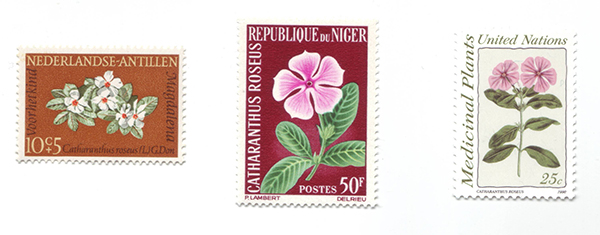I have a fascination with Nature's chemistry set, the amazing variety of very complex molecules which can often defy synthesis by modern synthetic organic chemistry. Looking back on my previous articles on this theme presented using both stamps and molecular models, I have concentrated to date on 'Nature's nasties', those chemicals which if ingested can likely give you a very bad day, if in fact you live to the next!
Nature isn't always nasty, in fact quite the contrary, it has provided a wealth of important drugs many of which are based on traditional medicines. One of the major concerns of habitat loss around the world is that we may be losing flora with potential leads to new drugs. To balance the past article themes I start a series showing beneficial plants.
The Madagascan periwinkle Catharanthus roseus as its name suggests is endemic to Madagascar and now often found as a garden annual. It has provided two very important drugs, vinblastine and vincristine. They are almost identical chemically apart from a functional group (see structural formulae). Vinblastine is used to treat various illnesses notably childhood leukemia. Vincristine's various roles notably include the treatment of Hodgkin's disesase.
Since their isolation and development as drugs in the late 50s and early 60s in a collaboration between Canadian researches and the Eli Lilly drug company, many thousands of patients have benefited from these drugs. Some useful resources on the discovery and action of these class of drugs known as the Vinca alkaloids is provided below (the plant was formerly in the genus Vinca).
The story leading to their final drug development is a fascinating one and interested readers are referred to the resources below. A certain amount of serendipity was involved but won't give a spoiler here except to remark that the plant extracts were initially being studied for one type of condition but found out to be far more effective for the type of conditions described above.


Vinblastine (left) and vincristine (right) which differ just by a methyl or aldehyde functional group (highlighted with green spots).
Structural formulae courtesy of molview.org where many chemicals like these can be downloaded from a database.

Vinblastine built with the Molymod molecular model system using its shorter open bonds. I enjoy building these types of complex molecules because it keeps the brain cells from becoming rusty interpreting the flat structural formula to build its correct 3D structure.
The stereochemistry of the bonding is hopefully correct but with many single bonds which can rotate and some flexible unsaturated six membered carbon rings, the exact 3D conformer may differ from that shown.
Philately
From online searches to date there seem relatively few stamps showing the plant and have not found any that illustrate the chemical aspects of its medicinal properties. Those found showing the plant were however part of a series for the United Nations set showing medicinal plants.

Left to right. Netherlands Antilles 1964, one of a set of four. Republic de Niger 1964, one of a set of nine. United Nations 1990, one of a set of six.

Magadascar issued its own stamp in 2000, shown here on an attractive first day cover.

The periwinkle is shown as one of a set of four on this first day cover from Kiribati in 1994. The plant is now widely naturalised throughout appropriate regions of the world.